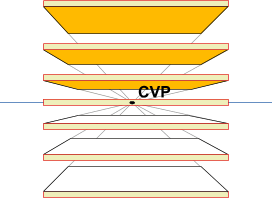Drawing Boards: Difference between revisions
From DT Online
m (Corrected Category) |
m (Added Category) |
||
| Line 19: | Line 19: | ||
[[Category:Graphics Starters]] | [[Category:Graphics Starters]] | ||
[[Category:Perspective]] | |||
Revision as of 16:34, 30 December 2015
A freehand sketching exercise to help give a 'feel' for how Oblique Perspective can be used to view objects.
- Take a sheet of paper and a drawing pencil.
- Draw an horizontal line and mark a near its centre - these will be the Central Vanishing Point (CVP) and it sits on the Eye Line or Horizon Line.
- Imagine you are looking at a the edge of a drawing board and draw a thin rectangle astride the horizon line.
- Project copies of this rectangle directly above and below it.
- Join the corners of each rectangle to the CVP.
- Make a judgement about where to draw the horizontal lines to represent the rear edges of the drawing boards.
- Use lining in and shading to give the impression you are looking above and below a drawing board.
Note: Even though you have drawn all rectangles the same size directly above each other, you may notice they appear wider as they cross the Eye Line. This is a common Optical Illusion and artists compensate for it in their paintings. Also, in Greek architecture, tall pillars were made thinner in the middle so they might look parallel when viewed.
